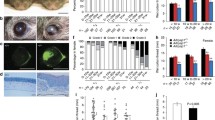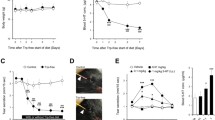Abstract
The purpose of this study is to investigate if the cholinergic stimulation by carbachol on tear secretion is a direct process or if it is also mediated by purinergic mechanisms. Experiments were performed in New Zealand male rabbits. The amount of tear secretion was measured with Schirmer’s test and then analyzed by a HPLC protocol in order to study the nucleotide levels. Animal eyes were instilled with carbachol (a cholinergic agonist), pirenzepine, gallamine and 4-DAMP (muscarinic antagonists), PPADS, suramin and reactive blue 2 (purinergic antagonists), and a P2Y2 receptor small interfering RNA (siRNA). Tear secretion increased with the instillation of carbachol, approximately 84 % over control values 20 min after the instillation and so did Ap4A and ATP release. When we applied carbachol in the presence of muscarinic antagonists, tear volume only increased to 4 % with atropine, 12 % in the case of pirenzepine, 3 % with gallamine, and 8 % with 4-DAMP. In the presence of carbachol and purinergic antagonists, tear secretion was increased to 12 % (all values compared to basal tear secretion). By analyzing tear secretion induced with carbachol in presence of a P2Y2 receptor siRNA, we found that tear secretion was diminished to 60 %. The inhibition of tear secretion in the presence of carbachol and purinergic antagonists or P2Y2 siRNA occurred with no apparent change in the tear amount of Ap4A. These experiments demonstrated the participation of Ap4A in lacrimal secretion process.





Similar content being viewed by others
References
Records RE (1979) Tear film. Physiology of the eye and visual system 47–67
Dilly PN (1994) Structure and function of the tear film. Adv Exp Med Biol 350:239–247
Acosta MC, Peral A, Luna C, Pintor J, Belmonte C, Gallar J (2004) Tear secretion induced by selective stimulation of corneal and conjunctival sensory nerve fibers. Invest Ophthalmol Vis Sci 45(7):2333–2336
Hodges RR, Dartt DA (2003) Regulatory pathways in lacrimal gland epithelium. Int Rev Cytol 231:129–196
Ruskell GL (1969) Changes in nerve terminals and acini of the lacrimal gland and changes in secretion induced by autonomic denervation. Z Zellforsch Mikrosk Anat 94(2):261–281
Ruskell GL (1971) The distribution of autonomic post-ganglionic nerve fibres to the lacrimal gland in monkeys. J Anat 109(Pt 2):229–242
Dartt DA, Baker AK, Vaillant C, Rose PE (1984) Vasoactive intestinal polypeptide stimulation of protein secretion from rat lacrimal gland acini. Am J Physiol 247(5 Pt 1):G502–G509
Dartt DA, Donowitz M, Joshi VJ, Mathieu RS, Sharp GW (1984) Cyclic nucleotide-dependent enzyme secretion in the rat lacrimal gland. J Physiol 352:375–384
Pflugfelder SC, Solomon A, Dursun D, Li DQ (2002) Dry eye and delayed tear clearance: “a call to arms”. Adv Exp Med Biol 506(Pt B):739–743
Dartt DA, Botelho SY (1979) Protein in rabbit lacrimal gland fluid. Invest Ophthalmol Vis Sci 18(11):1207–1209
Dartt DA, Knox I, Palau A, Botelho SY (1980) Proteins in fluids from individual orbital glands and in tears. Invest Ophthalmol Vis Sci 19(11):1342–1347
Dartt DA, Moller M, Poulsen JH (1981) Lacrimal gland electrolyte and water secretion in the rabbit: localization and role of (Na+ + K+)-activated ATPase. J Physiol 321:557–569
Ubels JL, Foley KM, Rismondo V (1986) Retinol secretion by the lacrimal gland. Invest Ophthalmol Vis Sci 27(8):1261–1268
Rismondo V, Ubels JL (1987) Isotretinoin in lacrimal gland fluid and tears. Arch Ophthalmol 105(3):416–420
Rismondo V, Ubels JL, Osgood TB (1988) Tear secretion and lacrimal gland function of rabbits treated with isotretinoin. J Am Acad Dermatol 19(2 Pt 1):280–285
Ubels JL, Rismondo V, Osgood TB (1989) The relationship between secretion of retinol and protein by the lacrimal gland. Invest Ophthalmol Vis Sci 30(5):952–960
Pintor J, Carracedo G, Alonso MC, Bautista A, Peral A (2002) Presence of diadenosine polyphosphates in human tears. Pflugers Arch 443(3):432–436
Pintor J, Peral A, Hoyle CH, Redick C, Douglass J, Sims I, Yerxa B (2002) Effects of diadenosine polyphosphates on tear secretion in New Zealand white rabbits. J Pharmacol Exp Ther 300(1):291–297
Pintor J, Diaz-Hernandez M, Gualix J, Gomez-Villafuertes R, Hernando F, Miras-Portugal MT (2000) Diadenosine polyphosphate receptors. From rat and guinea-pig brain to human nervous system. Pharmacol Ther 87(2–3):103–115
Pintor J, Miras-Portugal MT (1995) A novel receptor for diadenosine polyphosphates coupled to calcium increase in rat midbrain synaptosomes. Br J Pharmacol 115(6):895–902
Pintor J, Sanchez-Nogueiro J, Irazu M, Mediero A, Pelaez T, Peral A (2004) Immunolocalisation of P2Y receptors in the rat eye. Purinergic Signal 1(1):83–90. doi:10.1007/s11302-004-5072-5
Pintor J, Peral A, Pelaez T, Martin S, Hoyle CH (2003) Presence of diadenosine polyphosphates in the aqueous humor: their effect on intraocular pressure. J Pharmacol Exp Ther 304(1):342–348. doi:10.1124/jpet.102.041368
Mediero A, Guzman-Aranguez A, Crooke A, Peral A, Pintor J (2008) Corneal re-epithelialization stimulated by diadenosine polyphosphates recruits RhoA/ROCK and ERK1/2 pathways. Invest Ophthalmol Vis Sci 49(11):4982–4992. doi:10.1167/iovs. 07-1583
Peral A, Carracedo G, Acosta MC, Gallar J, Pintor J (2006) Increased levels of diadenosine polyphosphates in dry eye. Invest Ophthalmol Vis Sci 47(9):4053–4058
Carracedo G, Guzman-Aranguez A, Loma P, Pintor J (2013) Diadenosine polyphosphates release by human corneal epithelium. Exp Eye Res 113C:156–161
van Bijsterveld OP (1969) Diagnostic tests in the Sicca syndrome. Arch Ophthalmol 82(1):10–14
Poulin B, Butcher A, McWilliams P, Bourgognon JM, Pawlak R, Kong KC, Bottrill A, Mistry S, Wess J, Rosethorne EM, Charlton SJ, Tobin AB (2010) The M3-muscarinic receptor regulates learning and memory in a receptor phosphorylation/arrestin-dependent manner. Proc Natl Acad Sci U S A 107(20):9440–9445. doi:10.1073/pnas.0914801107
Dartt DA (2004) Control of mucin production by ocular surface epithelial cells. Exp Eye Res 78(2):173–185
Guzman-Aranguez A, Pintor J (2012) Focus on molecules: purinergic P2Y(2) receptor. Exp Eye Res 105:83–84
Pintor J, Miras-Portugal MT (1995) P2 purinergic receptors for diadenosine polyphosphates in the nervous system. Gen Pharmacol 26(2):229–235
Dartt DA (2001) Regulation of lacrimal gland secretion by neurotransmitters and the EGF family of growth factors. Exp Eye Res 73(6):741–752
Zoukhri D, Dartt DA (1995) Cholinergic activation of phospholipase D in lacrimal gland acini is independent of protein kinase C and calcium. Am J Physiol 268(3 Pt 1):C713–C720
Carrasquero LM, Delicado EG, Sanchez-Ruiloba L, Iglesias T, Miras-Portugal MT (2010) Mechanisms of protein kinase D activation in response to P2Y(2) and P2X7 receptors in primary astrocytes. Glia 58(8):984–995
Dartt DA, Hodges RR (2011) Cholinergic agonists activate P2X7 receptors to stimulate protein secretion by the rat lacrimal gland. Invest Ophthalmol Vis Sci 52(6):3381–3390
Acknowledgments
This work has been supported by a research grant by Ministerio de Ciencia e Innovación SAF-2010-16024, BFU-2012-31195, SAF-2013-44416-R, RETICS/OFTARED RD07/0062/0004, and UCM GR35/10-A-920777. AM-A is a fellowship holder of Universidad Complutense de Madrid.
Author information
Authors and Affiliations
Corresponding author
Rights and permissions
About this article
Cite this article
Fonseca, B., Martínez-Águila, A., Díaz-Hernández, M. et al. Diadenosine tetraphosphate contributes to carbachol-induced tear secretion. Purinergic Signalling 11, 87–93 (2015). https://doi.org/10.1007/s11302-014-9434-3
Received:
Accepted:
Published:
Issue Date:
DOI: https://doi.org/10.1007/s11302-014-9434-3




